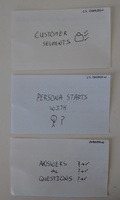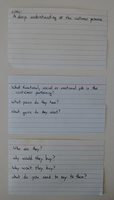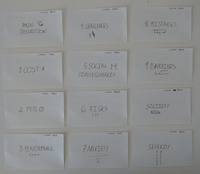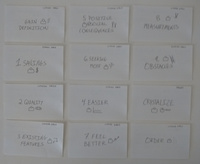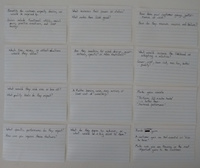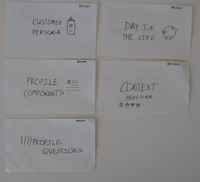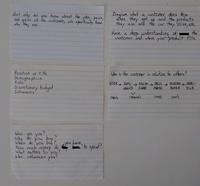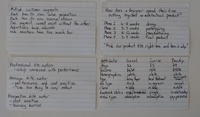Fifth Stage: Customer Segments
Research of known effective materials:
Udacity course: How to Build a Startup, Lesson 6: Customer Segments
Sections 1-9, 13-14, 26-27
Strategyzer: A day in the Life of a customer
Strategyzer: Business Model Generation Preview Pages 20-21
Strategyzer: Customer gains trigger questions
Strategyzer: Customer pains trigger questions
Strategyzer: Customer jobs trigger questions
Strategyzer: Identify high value jobs
Strategyzer: Value Proposition Design book preview Pages 19-26
Incorporation:
Card deck 1 of 6 Overview
Customer segments GOAL: A deep understanding of the customer persona. Persona starts with: What functional, social or emotional job is the customer performing? What pains do they have? What gains do they want? Provide answers to the questions: Who are they, why would they buy, why won't they buy. What do you need to say to them?
Card deck 2 of 6 Jobs
The tasks they are trying to perform. The problems they are trying to solve. Or the needs they are trying to satisfy. Functional jobs Perform a specific task to solve a specific problem. Mow the lawn Eat healthy write a report Social jobs Describe how customers want to be perceived by others Look good or gain power or status Look trendy Be seen as competent Emotional jobs Customer seeks a specific emotional state Feel good or secure Seeking peace of mind regarding investments Crucial or trivial? At what frequency does it occur? Rank each job according to its significance to the customer What constraints and limitations are imposed on the job based on its context?
Card deck 3 of 6 Pains
Pains Anything that prevents your customers from getting a job done. Can annoy customers before, during and after trying to get a job done. Or describes risks related to getting a job done badly or not at all. 1. Cost Takes a lot of time, too much money, or requires substantial efforts? 2. Feel What are their frustrations, annoyances, or things that give them a headache? 3. Performance What features are they missing? What performance issues annoy them or malfunctions do they cite? 4. Challenges Do they not understand how things work, have difficulties getting certain things done, or resist particular jobs for specific reasons? 5. Social consequences Are they afraid of losing face, power, trust or status? 6. Risks Are there financial, social, or technical risks. Or are they asking themselves what could go wrong? 7. Anxiety What are their big issues, concerns and worries? 8. Mistakes Are they using a solution the wrong way? What common mistakes do customers make? 9. Barriers Are their upfront investment costs, a steep learning curve, or other obstacles preventing adoption? Make pains concrete "Waiting in line for 10 minutes is a waste" is better than "I hate standing in line" Pain severity A customer pain can be extreme or moderate, similar to how jobs can be important or insignificant to the customer.
Card deck 4 of 6 Gains
Gains are benefits the customer expects, desires or would be surprised by. Gains include functional utility, social gains, positive emotions, and cost savings. 1. Savings Which time, money and effort reductions would they value. 2. Quality What would they wish more or less of? What quality levels do they expect? 3. Existing features What specific performance do they expect? How can you improve those features? 4. Easier A flatter learning curve, more services, or lower costs of ownership? 5. Positive social consequences What increases their power or status? What makes them look good? 6. Seeking most Are they searching for good design, guarantees, specific or more features? 7. Feel better What do they aspire to achieve, or what would be a big relief to them? 8. Measurements How does your customer gauge performance or cost? How do they measure success and failure? 9. Obstacles What would increase the likelihood of adopting a solution? Lower cost, lower risk, more fun, better quality? Make gains concrete "Performs 10 minutes faster" is better than "Increased performance" Rank your gains A customer gain can feel essential or nice to have. Make sure you are focusing on the most important gains to the customer
Card deck 4 of 6 Persona
Not only do you know about the pains and gains of the customers, you specifically know who they are. Profile Components position or title demographics role discretionary budget motivations Influencers Profile questions: Who are you? Why do you buy? Where do you buy? How much money do you have to spend? What matters to you? Who influences you? Day in the life Diagram what a customer does from when they get up and the products they use and the car they drive etc. Have a deep understanding of the customer and where your product fits. Who is the customer in relation to others? User->Influencer->Recommender->Decision Maker->Economic Buyer->Saboteur Teen Friends Dad Parents
Card deck 6 of 6 Examples
Simple two sided google search summary Multiple customer segments Each has its own value proposition each has it's own revenue stream one segment cannot exist without the other advertisers have google adwords web searchers have free search bar Company making kite boarding equipment Professional kite surfers - solely concerned with performance Average kit surfer - performance and cost sensitive - "one less thing to carry" effect Prospective kite surfer - cost sensitive - learning barrier Understanding the day in the life of the customer How does a designer spend their time putting together a architectural product? phase 1 design 6-8 weeks phase 2 prototyping 3-4 weeks phase 3 manufacturing 8-12 weeks phase 4 final product 3-4 weeks And our product fits right here and here's why JerseySquare Persona Attribute Gasol Junior Becky Age 32 15 24 Income $65k N/A $40K Demographics White White White Type Jersey Buyer Social statement social sports viewer Fan Type avid in-season casual Class middle middle middle Facebook Status single/compl. single in relationship rental type subscription subscription pay per rental
Execution:
Update your existing business model canvases (with snapshots), and popluate the customer segment area according to what you have learned here.
